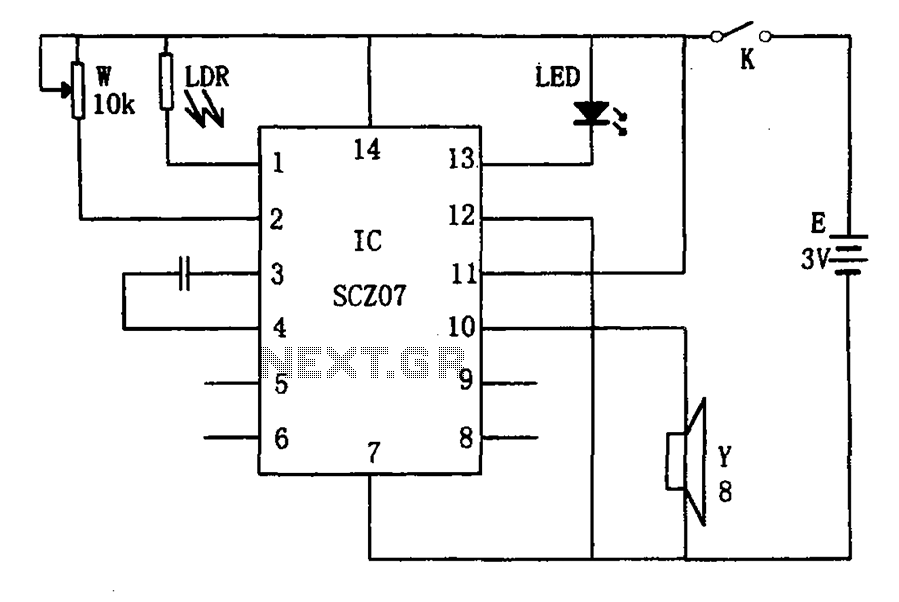
Weak light alarm SCZ07 a circuit diagram

The weak light alarm circuit is illustrated in the figure. The oscillator circuit's core component is the SCZ07. The input signal is controlled by a potentiometer (W) and the output signal is processed by a photoresistor (LDR). The circuit drives a speaker (Y) and a light-emitting diode (LED). Initially, the potentiometer (W) is set to its maximum position, and with the LDR positioned at a standard illuminance of 100 lux, the circuit does not vibrate, and the speaker (Y) remains silent. By fine-tuning the potentiometer (W) to decrease its resistance, the circuit activates at a certain threshold, causing the speaker to emit a beep sound. If the potentiometer is slightly adjusted back, the circuit ceases to vibrate, allowing for optimal tuning of the alarm. In this configuration, when the light level falls below the standard illuminance of 100 lux, the speaker emits a warning beep, and the LED lights up to indicate low light conditions. Conversely, when the light exceeds 100 lux, the alarm remains inactive, with the speaker silent and the LED off.
The weak light alarm circuit utilizes an oscillator based on the SCZ07 component, which serves as the primary control unit for the entire system. The circuit operation begins with the adjustment of the potentiometer (W), which modulates the input signal fed into the oscillator. The photoresistor (LDR) detects ambient light levels, allowing the circuit to react accordingly. When the light intensity is at or above 100 lux, the resistance of the LDR is low enough to prevent the oscillator from triggering the alarm. In this state, both the speaker (Y) and the LED remain inactive.
As the light intensity drops below 100 lux, the resistance of the LDR increases, which in turn affects the oscillator's performance. The fine-tuning of the potentiometer (W) is crucial, as it sets the sensitivity of the circuit. By decreasing the resistance of the potentiometer, the circuit reaches a threshold where it can detect the lower light levels. This results in the activation of the oscillator, which generates a signal that drives the speaker (Y) to produce a beep sound, alerting the user to the low light condition. Simultaneously, the LED illuminates, providing a visual indication of the situation.
The design of this circuit is beneficial in environments where monitoring light levels is essential, such as in agricultural settings for plant growth or in security systems to detect unauthorized entry during low-light conditions. The adjustable sensitivity via the potentiometer allows for customization based on specific requirements, making the circuit versatile for various applications. Overall, the weak light alarm circuit effectively combines audio and visual alerts to ensure timely responses to changes in ambient light conditions. As shown in FIG weak light alarm circuit. The core of the oscillator circuit for the alarm SCZ07. Its input signal by the potentiometer W, control, output signal photoresistor LDR driven speaker Y, a light emitting diode LED work.When adjusting circuit is first placed in the maximum W position, LDR placed standard illuminance 100 lux, and the circuit can not afford to vibration, speaker Y does not sound. Fine-tune the W, so that the resistance from big to small, when adjusted to a certain value, start-up circuit, the speaker issued a beep.
sound, then W slightly recall some of the circuit just stop vibration, the alarm on a good tune.For this circuit, when the light is below standard illuminance (100 lux), the speaker issued a warning beep. sound, while the light emitting diode LED lights to show the light is dim. When light is greater than 100 lux, the alarm does not work, that the speaker does not sound, the light emitting diode does not shine.
The weak light alarm circuit utilizes an oscillator based on the SCZ07 component, which serves as the primary control unit for the entire system. The circuit operation begins with the adjustment of the potentiometer (W), which modulates the input signal fed into the oscillator. The photoresistor (LDR) detects ambient light levels, allowing the circuit to react accordingly. When the light intensity is at or above 100 lux, the resistance of the LDR is low enough to prevent the oscillator from triggering the alarm. In this state, both the speaker (Y) and the LED remain inactive.
As the light intensity drops below 100 lux, the resistance of the LDR increases, which in turn affects the oscillator's performance. The fine-tuning of the potentiometer (W) is crucial, as it sets the sensitivity of the circuit. By decreasing the resistance of the potentiometer, the circuit reaches a threshold where it can detect the lower light levels. This results in the activation of the oscillator, which generates a signal that drives the speaker (Y) to produce a beep sound, alerting the user to the low light condition. Simultaneously, the LED illuminates, providing a visual indication of the situation.
The design of this circuit is beneficial in environments where monitoring light levels is essential, such as in agricultural settings for plant growth or in security systems to detect unauthorized entry during low-light conditions. The adjustable sensitivity via the potentiometer allows for customization based on specific requirements, making the circuit versatile for various applications. Overall, the weak light alarm circuit effectively combines audio and visual alerts to ensure timely responses to changes in ambient light conditions. As shown in FIG weak light alarm circuit. The core of the oscillator circuit for the alarm SCZ07. Its input signal by the potentiometer W, control, output signal photoresistor LDR driven speaker Y, a light emitting diode LED work.When adjusting circuit is first placed in the maximum W position, LDR placed standard illuminance 100 lux, and the circuit can not afford to vibration, speaker Y does not sound. Fine-tune the W, so that the resistance from big to small, when adjusted to a certain value, start-up circuit, the speaker issued a beep.
sound, then W slightly recall some of the circuit just stop vibration, the alarm on a good tune.For this circuit, when the light is below standard illuminance (100 lux), the speaker issued a warning beep. sound, while the light emitting diode LED lights to show the light is dim. When light is greater than 100 lux, the alarm does not work, that the speaker does not sound, the light emitting diode does not shine.





